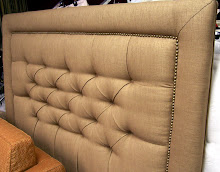
 This wing chair was recently recovered in a luxurious russet colored mohair.
This wing chair was recently recovered in a luxurious russet colored mohair.Mohair is shorn from the Angora goat. No to be confused with an Angora Rabbit, the angora goat is thought to originate from the mountains of Tibet making their way to Turkey in the 16th century. Until 1849 the Turkish province of Ankarra was the sole producer of Angora goats. Charles V is believed to be the first to bring Angora goats to Europe. In 1849 Angora goats made their way to America as a gift from Turkey. Today South Africa and the United States are the largest mohair producers, with the majority of Amerian mohair being produced in Texas.
Mohair is composed mostly of keratin, a protein substance similar to wool. Mohair is one of the oldest textile fibers in use. It is both durable and resilient. It is notable for its high luster and sheen, and is often used in fiber blends to add these qualities to a textile. Mohair also takes dye exceptionally well. Mohair has great insulating properties, making it warm. It is also durable, moisture-wicking, stretch and flame resistant, and crease resistant. Mohair increases its diameter with the age of the goat, growing along with the animal. This means fine hair from younger animals is used for finer applications such as clothing, and the thicker hair from older animals is more often used for carpets and heavy fabrics intended for outerwear.
Furniture upholstered with mohair fabric is undeniably beautiful. One needs to take care, however, with how it will be applied. Because it's so thick, it is best to use mohair on pieces that have basic tailoring - such as this chair. Mohair would be a poor choice for anything with skirting or gathers.Even the welting is usually done in a different material, such as the leather shown on this piece. (Welting is the cording that runs between joined pieces).
It's always important to remember that not every fabric will work for every job. When in doubt, ask a reputable upholsterer for his or her advice. They've generally seen it all and can help you steer clear of disappointment.






1 comment:
Mohair velvet is timeless and never get used .
I use it for decoration in the Alpes because in the south of France it is a" warmy fabric"
Post a Comment